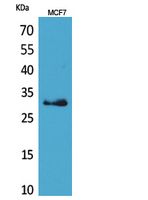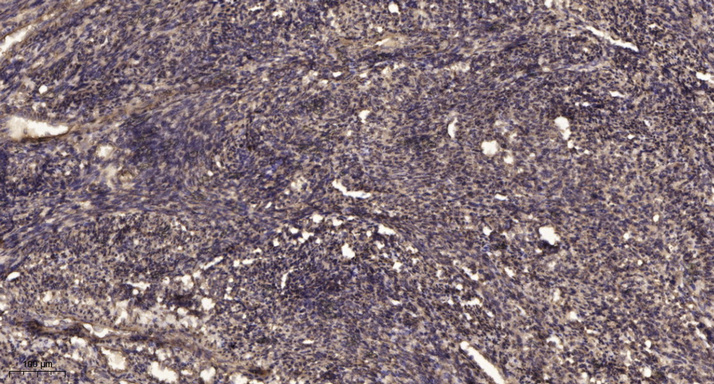KLK1 Polyclonal Antibody
- Catalog No.:YT5449
- Applications:WB;IHC
- Reactivity:Human;Mouse
- Target:
- Kallikrein-1
- Fields:
- >>Renin-angiotensin system;>>Endocrine and other factor-regulated calcium reabsorption
- Gene Name:
- KLK1
- Protein Name:
- Kallikrein-1
- Human Gene Id:
- 3816
- Human Swiss Prot No:
- P06870
- Mouse Swiss Prot No:
- P15947
- Immunogen:
- The antiserum was produced against synthesized peptide derived from the Internal region of human KLK1. AA range:81-130
- Specificity:
- KLK1 Polyclonal Antibody detects endogenous levels of KLK1 protein.
- Formulation:
- Liquid in PBS containing 50% glycerol, 0.5% BSA and 0.02% sodium azide.
- Source:
- Polyclonal, Rabbit,IgG
- Dilution:
- WB 1:500-2000;IHC 1:50-300
- Purification:
- The antibody was affinity-purified from rabbit antiserum by affinity-chromatography using epitope-specific immunogen.
- Concentration:
- 1 mg/ml
- Storage Stability:
- -15°C to -25°C/1 year(Do not lower than -25°C)
- Other Name:
- KLK1;Kallikrein-1;Kidney/pancreas/salivary gland kallikrein;Tissue kallikrein
- Observed Band(KD):
- 29kD
- Background:
- Kallikreins are a subgroup of serine proteases having diverse physiological functions. Growing evidence suggests that many kallikreins are implicated in carcinogenesis and some have potential as novel cancer and other disease biomarkers. This gene is one of the fifteen kallikrein subfamily members located in a cluster on chromosome 19. This protein is functionally conserved in its capacity to release the vasoactive peptide, Lys-bradykinin, from low molecular weight kininogen. [provided by RefSeq, Jul 2008],
- Function:
- catalytic activity:Preferential cleavage of Arg-|-Xaa bonds in small molecule substrates. Highly selective action to release kallidin (lysyl-bradykinin) from kininogen involves hydrolysis of Met-|-Xaa or Leu-|-Xaa.,function:Glandular kallikreins cleave Met-Lys and Arg-Ser bonds in kininogen to release Lys-bradykinin.,online information:Kallikrein entry,PTM:The O-linked polysaccharides on Ser-93, Ser-104 and Ser-167 are probably the mucin type linked to GalNAc. In PubMed:3163150, GalNAc was detected with the corresponding peptides but not located.,similarity:Belongs to the peptidase S1 family.,similarity:Belongs to the peptidase S1 family. Kallikrein subfamily.,similarity:Contains 1 peptidase S1 domain.,tissue specificity:Isoform 2 is expressed in pancreas, salivary glands, kidney, colon, prostate gland, testis, spleen and the colon adenocarcinoma cell line T84.,
- Subcellular Location:
- nucleus,extracellular exosome,
- Expression:
- Isoform 2 is expressed in pancreas, salivary glands, kidney, colon, prostate gland, testis, spleen and the colon adenocarcinoma cell line T84.
- June 19-2018
- WESTERN IMMUNOBLOTTING PROTOCOL
- June 19-2018
- IMMUNOHISTOCHEMISTRY-PARAFFIN PROTOCOL
- June 19-2018
- IMMUNOFLUORESCENCE PROTOCOL
- September 08-2020
- FLOW-CYTOMEYRT-PROTOCOL
- May 20-2022
- Cell-Based ELISA│解您多样本WB检测之困扰
- July 13-2018
- CELL-BASED-ELISA-PROTOCOL-FOR-ACETYL-PROTEIN
- July 13-2018
- CELL-BASED-ELISA-PROTOCOL-FOR-PHOSPHO-PROTEIN
- July 13-2018
- Antibody-FAQs
- Products Images

- Western Blot analysis of MCF7 cells using KLK1 Polyclonal Antibody. Secondary antibody(catalog#:RS0002) was diluted at 1:20000

- Immunohistochemical analysis of paraffin-embedded human uterus. 1, Antibody was diluted at 1:200(4° overnight). 2, Tris-EDTA,pH9.0 was used for antigen retrieval. 3,Secondary antibody was diluted at 1:200(room temperature, 45min).



